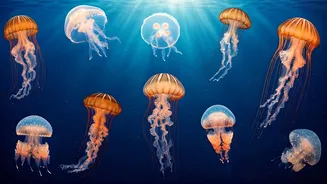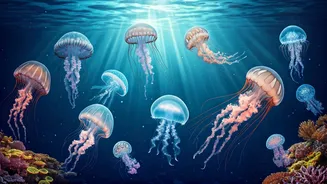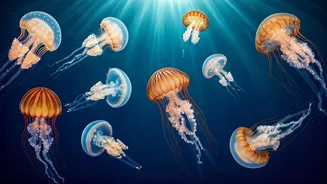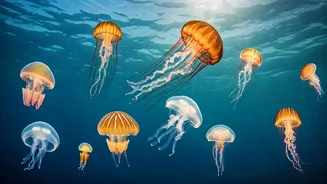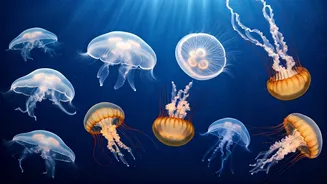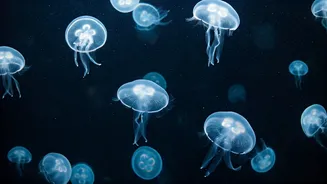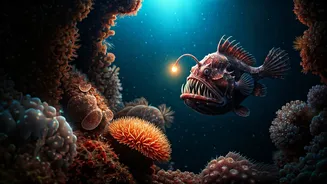White-spotted Jellyfish
The White-spotted jellyfish, also known as *Mastigias papua*, is a frequent sight in Indo-Pacific waters, especially near Australia. It has a bell covered
in white spots, giving it a distinctive appearance. These jellyfish are relatively large, and they often gather in massive swarms, especially in enclosed bays or lagoons. They have a symbiotic relationship with algae, which live in their tissues. These algae provide the jellyfish with nutrients through photosynthesis. Because of this, the jellyfish can often be seen swimming upside down to get maximum sunlight to help this process. These jellyfish are popular in aquariums due to their striking visual appearance and relatively docile nature. The White-spotted jellyfish’s life cycle includes a polyp stage, where they attach to the seabed before becoming the free-swimming medusa form that is often seen.
Mangrove Box Jellyfish
The Mangrove box jellyfish (*Tripedalia cystophora*) stands out for its unique habitat preference and structure. It is found specifically in mangrove swamps in tropical and subtropical regions. This jellyfish has a box-shaped bell, which is characteristic of the box jellyfish family. What makes it interesting is its relationship with its environment. They have around 24 eyes, giving them a remarkable vision for their size, enabling them to navigate the often murky waters of their habitat. The Mangrove box jellyfish actively hunts tiny prey like copepods, unlike many other jellyfish that drift passively. Its choice of home and hunting tactics show its specialized adaptation to the mangrove environment.
Atolla Jellyfish
The Atolla jellyfish, often called the 'coronate jellyfish,' is a fascinating species found in the deep ocean. It is known for its bioluminescence, particularly the ability to flash a ring of blue light when threatened. This defensive behavior is known as the 'burglar alarm,' which is thought to attract larger predators to attack whatever is attacking the jellyfish, and providing the Atolla jellyfish an opportunity to escape. These jellyfish are typically small to medium in size, living far below the surface. They have a prominent central bell, encircled by numerous tentacles. The bioluminescence and the deep-sea habitat make the Atolla jellyfish a captivating example of adaptation in the planet's dark and mysterious depths.
Lion’s Mane Jellyfish
The Lion's mane jellyfish (*Cyanea capillata*) is one of the largest known jellyfish species, and it is known for its impressive size and striking appearance. Found in cold, northern waters, this jellyfish can have a bell diameter exceeding several feet, with tentacles that can extend to over a hundred feet, making it one of the largest creatures in the ocean. The color of the Lion's mane jellyfish varies depending on its size and location, ranging from reddish-brown to orange and purple. Its long, flowing tentacles resemble a lion's mane, giving it its name. Despite its size and venomous sting, the Lion's mane jellyfish plays a crucial role in its ecosystem as a predator of smaller jellyfish and other plankton.
Cauliflower Jellyfish
The Cauliflower jellyfish (*Cephea cephea*) gets its name from its distinctive appearance. It looks like a cauliflower head. Commonly found in the Indo-Pacific, these jellyfish are typically large and often found in coastal waters. Instead of tentacles, they have many small, club-shaped oral arms used to capture plankton. The Cauliflower jellyfish is a common sight in the waters of Australia and the surrounding regions, frequently gathering in large numbers. While they have stinging cells, their sting is generally mild to humans. The Cauliflower jellyfish is an important part of the food chain, serving as prey for larger animals.
Black Sea Nettle
The Black sea nettle (*Chrysaora melanaster*) is a striking jellyfish known for its dark color and the complex patterns on its bell. Found primarily in the Pacific Ocean, this species ranges from the waters off of California to the Sea of Japan. The bell of the Black sea nettle can range from a few inches to over a meter in diameter. The intricate patterns and dark coloration of the Black sea nettle’s bell are distinct features that separate it from other jellyfish. Like other jellyfish, the Black sea nettle has stinging cells in its tentacles. Despite their potentially painful sting, these jellyfish are a natural part of their ecosystems, playing roles as both predators and prey. They feed on plankton and other small organisms, and are in turn eaten by sea turtles and other marine animals.
Upside-down Jellyfish
The Upside-down jellyfish (*Cassiopea andromeda*) demonstrates a unique adaptation. It is found in shallow, tropical waters and is often found on the seabed. Unlike most jellyfish, the Upside-down jellyfish rests upside down on the seafloor, with its tentacles facing upwards. They use this posture to expose symbiotic algae in their tissues to sunlight. The algae then produce nutrients through photosynthesis, providing a food source for the jellyfish. The Upside-down jellyfish is also unique due to its lack of a distinct bell, instead having a flattened, disc-like form. They are often found in large groups in clear, sunlit waters. Their unusual orientation and reliance on symbiotic relationships make them a fascinating species.
Narcomedusae Jellyfish
The Narcomedusae jellyfish are a group of deep-sea jellyfish that have several distinctive characteristics. Found in the open ocean, these jellyfish are known for their intricate body structures and feeding habits. They have a bell that is often bell-shaped or oval, with a large, gelatinous body. Their tentacles are typically long and numerous, used for catching prey. One of the distinguishing features of the Narcomedusae jellyfish is their predatory behavior. They feed on other jellyfish and marine organisms. Many species of Narcomedusae are also bioluminescent, producing light to attract prey or as a defense mechanism. They play important roles in the deep-sea ecosystem, preying on other jellies and serving as a food source for larger predators.
Crystal Jellyfish
The Crystal jellyfish (*Aequorea victoria*) is famous for its bioluminescence and its use in scientific research. Native to the Pacific Ocean, this jellyfish is relatively small and transparent, with a bell that is often nearly clear. It is best known for producing green fluorescent protein (GFP), which emits green light. The discovery of GFP in the Crystal jellyfish was a major breakthrough in biology, leading to a Nobel Prize. Scientists use GFP as a tool to study various biological processes. Its ability to glow, and its role in scientific studies, make the Crystal jellyfish an important subject of interest for biologists worldwide.
Fried Egg Jellyfish
The Fried egg jellyfish (*Phacellophora camtschatica*) gets its name from its resemblance to a fried egg. It is a large jellyfish with a translucent bell and a yellow-orange central disc that looks like the yolk of the egg. Found in the Pacific and Atlantic Oceans, this jellyfish is known for its considerable size and distinctive appearance. The Fried egg jellyfish is a predator, feeding on other jellyfish, plankton, and small fish. They often gather in large numbers, creating an impressive sight. Though their sting is relatively mild to humans, they play a vital role in their ecosystems, serving as both predators and food sources for larger animals. The unique appearance of the Fried egg jellyfish and its feeding habits make it a captivating creature of the sea.
